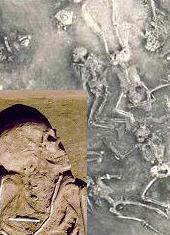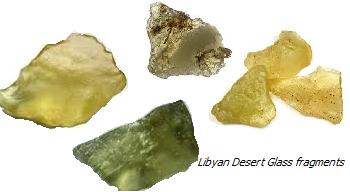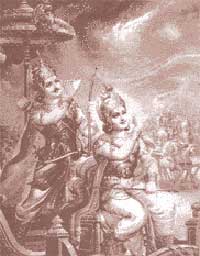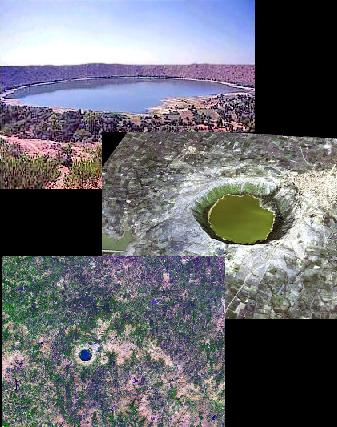400 kilometers northeast of Bombay there is a circular 2,154-metre-diameter crater, the Lonar crater. It has been dated at less than 50,000 years old, and could conceivably be related to a nuclear attack or mishap of antiquity.
No traces of any expected meteoric material has ever been found in the vicinity, and this is the world's only known "impact" crater in solid basalt. Indications of a tremendous shock exceeding 600,000 atmospheres combined with intense, sudden heat has been determined.
In Rajasthan, India ten miles west of Jodhpur -there is a heavy layer of radioactive ash ,it covers about three-square miles. Scientists investigated the site. It has been noted that has always been a very high rate of birth defects and cancer in the area. The levels of radiation there registered so high on investigators' gauges that the Indian government cordoned off the region.
|
Prehistoric and Ancient Atomic Ruins
|
|
|
"If atomic warfare were actually used in the distant past and not just imagined, there must still exist some indications of a civilization advanced enough to develop or even to know about atomic power. One does find in some of the ancient writings of India some descriptions of advanced scientific thinking which seemed anachronistic to the age from which they come." Charles Berlitz - Mysteries from Forgotten Worlds
 |
In the early 1900s, archeologists uncovered the ruins of a large ancient town. It has been labeled Mohenjo Daro [mound of the dead] ,one of the most developed civilizations in the world. The life in this ancient civilization that existed for 2-3,000 years is fascinating, however the death of Mohenjo Daro is intricately more intriguing .
Scientists were unable to explain the reason of the town's sudden demise.
|
No indications of a monstrous flood, no fragments of weapons, or anything else that would signify a natural disaster or war in the classical sense. Archaeologists were perplexed, the collected facts indicated that the catastrophe occurred very unexpectedly and lasted a very short time.
David Davneport and Ettore Vincenti [Atomic Destruction 2000 BC] espouse a theory that Mohenjo Daro had been destroyed with a nuclear blast. Stratums of clay and green glass apparently melted by extreme high temperature ,and hardened immediately afterwards. Similar stratums of green glass can also be found in the Nevada desert following nuclear tests, as well as in the Libyan desert - [unexplainable?] .
  |
"When archeologists got to the street level, people were lying dead in the street - after thousands of years." David H. Childress - Technology of the Gods: The Incredible Sciences of the Ancients. Had a natural catastrophe, disease, or conventional war brought down Mohenjo Daro the bodies of its citizenry would have been ravaged by animals , and the city plundered by subsequent looters over the centuries. This never happened, Dozens of skeletons were found in the area of Mohenjo-Daro – their radioactivity exceeded the norm almost 50 times.
|
Russian researchers found a skeleton with a radioactive level 50 times greater than normal. Other cities have been found in northern India which also show evidence of intense explosions .{Riddles of Ancient History - Sputnik Magazine - Alexander Gorbovsky}
 |
One such city, found between the Ganges and the mountains of Rajmahal, seems to have been subjected to incredible heat. Huge masses of this ancient city are fused together, fused and melted in a manner that only extremely high temperatures can achieve. There is no proof of a volcanic eruption at any of these cities, heat this intense can only be explained by a nuclear blast or similar other unknown force.
Modern analysis showed, that fragments of Mohenjo Daro were melted with extreme high temperature – not less than 1,500° centigrade. Scientists have also found a strictly outlined epicenter, where everything was leveled. Devastation lessened towards the outskirts.
|
Julius Robert Oppenheimer, theoretical physicist and the Supervising Scientist for the Manhattan Project, the developer of the atomic bomb During a question and answer period a student asked a question to which Oppenheimer gave a strange answer:
|
Libyan Desert Glass
| South of Cairo and west of the Nile valley there are mysterious deposits of yellow-green glass among the sand dunes of the Libyan Desert. This Libyan desert glass, as it has been named, was discovered in 1932 by an English geologist who was conducting a survey of the Egyptian desert.
|
 |
There is no meteorite impact crater anywhere in the vicinity of the Libyan desert Glass, although it is conceivable that the glass could have formed when a meteorite exploded in mid-air above the desert, a so-called "soft impact." A soft impact meteorite is believed to have occurred in 1908 at Tunguska in Siberia.
Geologists give a date of somewhere around 28,000,000 years ago for this hypothesized meteorite impact to have occurred . We don't know that a soft impact could create the Libyan Desert Glass at all, it is speculation. We do know that an atomic explosion could create the Glass in question, it's proven.
"Bits of green glass, possibly fused in an ancient fireplace, is one thing; areas of fused green glass is something quite else again. And this site is not the only one. There are also the fused forts of the west coast of Scotland and elsewhere, in which one side only has been fused, as if hit from above by intense heat. Lightning occasionally fuses sand, but always in a root-like pattern.....So just what produced a whole stratum of green glass in various parts of Mesopotamia? " Ivan T. Sanderson
It is not inconceivable that the nuclear chain reactions that created the Libyan Dessert Glass were initiated by a natural force currently unbeknownst to man. The discovery of an ancient natural nuclear reactor was discovered in 1972 in Gabon, Africa [See Fact Sheet ], before this discovery scientists believed that only they could create the conditions essential for nuclear fission and atomic chain reactions suitable to blow up entire cities and create vast waste lands.
There are similar formations in Australia known as Edeowie glass, and in Tasmania as Darwin glass. The Austrailian / Tasmanian glass varies in color from Black - White to varying shades of light and Dark Green. The Tasmanian glass can be traced to an impact crater known as " Darwin Crater" .
In Rajasthan, India, a thick layer of radioactive ash covers a three-square mile area, where a housing development was under construction. Scientists are investigating, but modern contamination has not been ruled out. Natural Radioactivity in Soil and Radiation Levels of Rajasthan
|
|
|
|
Ancient Aircraft
Vimana Aircraft
Vimana: Flying Machines of the Ancients
The Chinese tales of fei che, flying vehicles, exhibit the first understanding, perhaps, that humans would fly only with some kind of technological apparatus. A hymn written in the second century B.C. speaks of deity appearing in chariots drawn by flying dragons."
- Dr. Benjamin B. Olshin  , "Mechanical Mythology: Private Descriptions of Flying Machines as Found in Early Chinese, Korean, Indian, and Other Texts" , "Mechanical Mythology: Private Descriptions of Flying Machines as Found in Early Chinese, Korean, Indian, and Other Texts"
Ancient Indian texts are crammed with references to gods who fought wars in the sky flying Vimanas equipped with deadly weapons . As well as being able to fly within the atmosphere, vimānas were said to be able to travel undersea and into space . Descriptions in the The Holy Vedas as well as later Indian literature detail vimānas of many different shapes and sizes: as well as later Indian literature detail vimānas of many different shapes and sizes:
|
There is a passage in the Ramayana which reads: which reads:
"The Puspaka car that resembles the Sun and belongs to my brother was brought by the powerful Ravan; that aerial and excellent car going everywhere at will .... that car resembling a bright cloud in the sky."
".. and the King [Rama] got in, and the excellent car at the command of the Raghira, rose up into the higher atmosphere."
The Samarangana Sutradhara, is a technical manuscript, composed in Sanskrit circa 1000 AD. It deals with techniques of warfare, and in particular with certain types of war machines. Samarangana Sutradhara translates to "battlefield commander"
|
 |
"Strong and durable must the body of the Vimana be made, like a great flying bird of light material. Inside one must put the mercury engine with its iron heating apparatus underneath. By means of the power latent in the mercury which sets the driving whirlwind in motion, a man sitting inside may travel a great distance in the sky. The movements of the Vimana are such that it can vertically ascend, vertically descend, move slanting forwards and backwards. With the help of the machines human beings can fly in the air and heavenly beings can come down to earth." It is with the help of one of these machines that "Gurkha flying in his swift and powerful Vimana hurled against the three cities of the Vrishis and Andhakas a single projectile Charged with all the power of the Universe."
It is in a similar device we know as the Enola Gay that A Paul W. Tibbets more recently dropped "a single projectile Charged with all the power of the Universe" on Hiroshima and Nagasaki.
| The Iron Thunderbolt of Gurkha <Back
The Mahabharatra, an ancient Indian poem , tells the following tale,
which may well be the tale of the ancient City of Mohenjo Daro.
Gurkha flying in his swift and powerful Vimana hurled against the three cities of the Vrishis and Andhakas a single projectile
Charged with all the power of the Universe.
An incandescent column of smoke and flame As bright as the thousand suns Rose in all its splendor... a perpendicular explosion with its billowing smoke clouds... ...the cloud of smoke rising after its first explosion formed into expanding round circles
like the opening of giant parasols...
..It was the unknown weapon, the Iron Thunderbolt, a gigantic messenger of death which reduced to ashes the entire race of the Vrishnis and Andhakas,
...The corpses were so burned As to be unrecognizable. The hair and nails fell out; Pottery broke without apparent cause, And the birds turned white.
After a few hours All foodstuffs were infected... ...to escape from this fire The soldiers threw themselves in streams To wash themselves and their equipment.
The Epic of Gilgamesh ca. 2500 BC contains a strikingly similar account of a day when "the heavens cried out, the earth bellowed an answer, lightning flashed forth, fire flamed upwards, it rained down death. The brightness vanished, the fire was extinguished. Everyone who was struck by the lightning was turned to ashes." ca. 2500 BC contains a strikingly similar account of a day when "the heavens cried out, the earth bellowed an answer, lightning flashed forth, fire flamed upwards, it rained down death. The brightness vanished, the fire was extinguished. Everyone who was struck by the lightning was turned to ashes."
|
|
Lonar Crater
A giant crater near Bombay is another possible indication of ancient nuclear activity in India . The circular Lonar crater , located over 300 miles northeast of Bombay , could be related to nuclear activity in ancient India.
Although it is believed to be from a meteor impact of around 50,000 years ago, little trace of meteoric material, was initially found in the vicinity, and this is the world’s only known “impact” crater in basalt. There are indications of a great shock (from a pressure exceeding 600,000 atmospheres) and intense, sudden heat . The crater was theoretically formed by the impact of the Meteor 60 meters wide
In the early 1970s work done by Smithsonian Institutions and the US Geological Survey, in collaboration with the Geological Survey of India discovered breccia containing shatter cones and material laden with maskelynite. The formation of maskelynite formation requires extremely high pressure and is created only during a hypervelocity impact.
Lonar crater was created by a meteor impact, not an ancient nuclear weapon.
|
 |
1. Oppenheimer And the Manhattan Project: Insights into J. Robert Oppenheimer, "Father of the Atomic Bomb"
2. In the Matter of J. Robert Oppenheimer: Politics, Rhetoric, and Self-Defense
3. Excavations at Mohenjo Daro, Pakistan 
|





